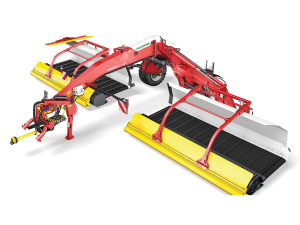Pöttinger launches silage additive tank for loader wagons and balers
Pottinger has released details of its newly developed LIQUIDO F front-mounted, multi-purpose silage additive tank.
 Pottinger says its recently released Mergento VT 9220 belt merger rake is better suited to ‘fragile’ crops such as lucerne and clover.
Pottinger says its recently released Mergento VT 9220 belt merger rake is better suited to ‘fragile’ crops such as lucerne and clover.
While most rakes or swathers are tine-based, over the last few years more and more manufacturers have been adding belt-based mergers to their product offerings.
The choice is brought about as some users believe that “raking” grass across the ground, particularly with larger machines, increases the risk of soil contamination and can also result in leaf loss.
The latest manufacturer to offer the solution is Pottinger, with its recently released Mergento VT 9220 belt merger. The company suggests it is better suited to ‘fragile’ crops such as lucerne, clover or alfalfa. However, it will also work equally well in conventional grass or straw crops.
Offering left, right or central delivery, the machine can also be set up to deliver two single swaths if required. Configured for central delivery, a working width of 9.2 metres can be achieved, while in side delivery, this reduces the overall working width to 8.7 metres.
An over-dimensioned, central-spine frame – fitted with rear wheel equipment – carries twin lateral frames that support the conveyor assemblies. Up front, the pick-up uses six rows of tine bars to lift the cut crop from the ground. With the aid of a roller crop press for short crops, it then drops the material from a point about 120mm above the conveyors.
Each conveyor assembly is centrally mounted, which is said to offer even weight distribution.
At the same time, the machine also delivers 3-D ground tracking – particularly on uneven ground or slopes. Carried on a chassis roller system, the conveyor units use three hydraulic cylinders to react quickly to ground adaption. It also offers vertical movement from +475mm to -195mm and lateral movement from +30 to -13 degrees.
To facilitate a clean pick-up, inclination of the conveyor in the direction of travel can be adjusted from +11.5 to 0 degrees.
Overall control of the unit, including direction of travel and belt positioning, is taken care of with an in-cab terminal.
The machine has the added benefit of automated switch on/ switch off at the headland.
This is aid to increase the output with tidy swath starts and finishes as the operator does not need to clear the belt between bouts.
Production is scheduled to start in August, with availability towards the end of the year.
Another Australian state has given the green light to virtual fencing, opening another market for Kiwi company Halter.
Farmer interest continues to grow as a Massey University research project to determine the benefits or otherwise of the self-shedding Wiltshire sheep is underway. The project is five years in and has two more years to go. It was done mainly in the light of low wool prices and the cost of shearing. Peter Burke recently went along to the annual field day held Massey's Riverside farm in the Wairarapa.
Applications are now open for the 2026 NZI Rural Women Business Awards, set to be held at Parliament on 23 July.
Ravensdown has announced a collaboration with Kiwi icon, Footrot Flats in an effort to bring humour, heart, and connection to the forefront of the farming sector.
Forest & Bird's Kiwi Conservation Club is inviting New Zealanders of all ages to embrace the outdoors with its Summer Adventure Challenges.
Fonterra has slashed another 50c off its milk price forecast as global milk flows shows no sign of easing.

OPINION: The release of the Natural Environment Bill and Planning Bill to replace the Resource Management Act is a red-letter day…
OPINION: Federated Farmers has launched a new campaign, swapping ‘The Twelve Days of Christmas’ for ‘The Twelve Pests of Christmas’ to…